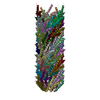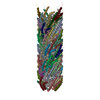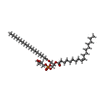+ Open data
Open data
- Basic information
Basic information
| Entry | Database: PDB / ID: 8cw4 | ||||||
|---|---|---|---|---|---|---|---|
| Title | CryoEM structure of the N-pilus from Escherichia coli | ||||||
 Components Components | Conjugal transfer protein TraM | ||||||
 Keywords Keywords | STRUCTURAL PROTEIN / conjugation / TraM / self transmissable plasmid / Pili | ||||||
| Function / homology | Conjugal transfer TrbC/type IV secretion VirB2 / TrbC/VIRB2 pilin / membrane / Chem-PGW / TraM Function and homology information Function and homology information | ||||||
| Biological species |  | ||||||
| Method | ELECTRON MICROSCOPY / single particle reconstruction / cryo EM / Resolution: 3 Å | ||||||
 Authors Authors | Bui, K.H. / Black, C.S. | ||||||
| Funding support |  Canada, 1items Canada, 1items
| ||||||
 Citation Citation |  Journal: Structure / Year: 2023 Journal: Structure / Year: 2023Title: Cryo-EM structure of the Agrobacterium tumefaciens T-pilus reveals the importance of positive charges in the lumen. Authors: Jaafar Amro / Corbin Black / Zakaria Jemouai / Nathan Rooney / Caroline Daneault / Natalie Zeytuni / Matthieu Ruiz / Khanh Huy Bui / Christian Baron /  Abstract: Agrobacterium tumefaciens is a natural genetic engineer that transfers DNA into plants, which is the most applied process for generation of genetically modified plants. DNA transfer is mediated by a ...Agrobacterium tumefaciens is a natural genetic engineer that transfers DNA into plants, which is the most applied process for generation of genetically modified plants. DNA transfer is mediated by a type IV secretion system in the cell envelope and extracellular T-pili. We here report the cryo-electron microscopic structures of the T-pilus at 3.2-Å resolution and of the plasmid pKM101-determined N-pilus at 3-Å resolution. Both pili contain a main pilus protein (VirB2 in A. tumefaciens, TraM in pKM101) and phospholipids arranged in a five-start helical assembly. They contain positively charged amino acids in the lumen, and the lipids are positively charged in the T-pilus (phosphatidylcholine) conferring overall positive charge. Mutagenesis of the lumen-exposed Arg91 in VirB2 results in protein destabilization and loss of pilus formation. Our results reveal that different phospholipids can be incorporated into type IV secretion pili and that the charge of the lumen may be of functional importance. | ||||||
| History |
|
- Structure visualization
Structure visualization
| Structure viewer | Molecule:  Molmil Molmil Jmol/JSmol Jmol/JSmol |
|---|
- Downloads & links
Downloads & links
- Download
Download
| PDBx/mmCIF format |  8cw4.cif.gz 8cw4.cif.gz | 929.9 KB | Display |  PDBx/mmCIF format PDBx/mmCIF format |
|---|---|---|---|---|
| PDB format |  pdb8cw4.ent.gz pdb8cw4.ent.gz | Display |  PDB format PDB format | |
| PDBx/mmJSON format |  8cw4.json.gz 8cw4.json.gz | Tree view |  PDBx/mmJSON format PDBx/mmJSON format | |
| Others |  Other downloads Other downloads |
-Validation report
| Summary document |  8cw4_validation.pdf.gz 8cw4_validation.pdf.gz | 2.8 MB | Display |  wwPDB validaton report wwPDB validaton report |
|---|---|---|---|---|
| Full document |  8cw4_full_validation.pdf.gz 8cw4_full_validation.pdf.gz | 2.9 MB | Display | |
| Data in XML |  8cw4_validation.xml.gz 8cw4_validation.xml.gz | 110.5 KB | Display | |
| Data in CIF |  8cw4_validation.cif.gz 8cw4_validation.cif.gz | 159.6 KB | Display | |
| Arichive directory |  https://data.pdbj.org/pub/pdb/validation_reports/cw/8cw4 https://data.pdbj.org/pub/pdb/validation_reports/cw/8cw4 ftp://data.pdbj.org/pub/pdb/validation_reports/cw/8cw4 ftp://data.pdbj.org/pub/pdb/validation_reports/cw/8cw4 | HTTPS FTP |
-Related structure data
| Related structure data |  27023MC  8cueC C: citing same article ( M: map data used to model this data |
|---|---|
| Similar structure data | Similarity search - Function & homology  F&H Search F&H Search |
- Links
Links
- Assembly
Assembly
| Deposited unit | 
|
|---|---|
| 1 |
|
- Components
Components
| #1: Protein | Mass: 10121.063 Da / Num. of mol.: 70 Source method: isolated from a genetically manipulated source Source: (gene. exp.)  Gene: traM, BON75_23740, CDC27_28740, DNQ45_22575, EIZ93_17580, ELT32_23125, GFY34_23075, GFY34_26255, JFD_05214, pMUR050_034, RCS44_P0033 Production host:  #2: Chemical | ChemComp-PGW / ( Has ligand of interest | Y | |
|---|
-Experimental details
-Experiment
| Experiment | Method: ELECTRON MICROSCOPY |
|---|---|
| EM experiment | Aggregation state: HELICAL ARRAY / 3D reconstruction method: single particle reconstruction |
- Sample preparation
Sample preparation
| Component | Name: N-pilus of the type IV secretion system of Escherichia coli. Type: COMPLEX / Entity ID: #1 / Source: RECOMBINANT |
|---|---|
| Molecular weight | Value: 24.8 kDa/nm / Experimental value: YES |
| Source (natural) | Organism:  |
| Source (recombinant) | Organism:  |
| Buffer solution | pH: 7.5 |
| Specimen | Embedding applied: NO / Shadowing applied: NO / Staining applied: NO / Vitrification applied: YES |
| Specimen support | Grid material: COPPER / Grid mesh size: 300 divisions/in. / Grid type: C-flat-1.2/1.3 |
| Vitrification | Instrument: FEI VITROBOT MARK IV / Cryogen name: ETHANE / Humidity: 100 % / Chamber temperature: 277 K Details: 3 uL of the sample was repeatedly applied and manually blotted three times using the multiple blotting technique prior to the Vitrobot step to increase the concentration of pili. |
- Electron microscopy imaging
Electron microscopy imaging
| Experimental equipment |  Model: Titan Krios / Image courtesy: FEI Company |
|---|---|
| Microscopy | Model: FEI TITAN KRIOS |
| Electron gun | Electron source:  FIELD EMISSION GUN / Accelerating voltage: 300 kV / Illumination mode: FLOOD BEAM FIELD EMISSION GUN / Accelerating voltage: 300 kV / Illumination mode: FLOOD BEAM |
| Electron lens | Mode: BRIGHT FIELD / Nominal magnification: 81000 X / Nominal defocus max: 3000 nm / Nominal defocus min: 500 nm |
| Image recording | Electron dose: 40 e/Å2 / Film or detector model: GATAN K3 BIOQUANTUM (6k x 4k) |
- Processing
Processing
| Software | Name: UCSF ChimeraX / Version: 1.3/v9 / Classification: model building / URL: https://www.rbvi.ucsf.edu/chimerax/ / Os: Linux / Type: package | ||||||||||||||||||||||||||||||||||||
|---|---|---|---|---|---|---|---|---|---|---|---|---|---|---|---|---|---|---|---|---|---|---|---|---|---|---|---|---|---|---|---|---|---|---|---|---|---|
| EM software |
| ||||||||||||||||||||||||||||||||||||
| CTF correction | Type: PHASE FLIPPING AND AMPLITUDE CORRECTION | ||||||||||||||||||||||||||||||||||||
| 3D reconstruction | Resolution: 3 Å / Resolution method: FSC 0.143 CUT-OFF / Num. of particles: 134660 / Symmetry type: POINT | ||||||||||||||||||||||||||||||||||||
| Atomic model building | Protocol: AB INITIO MODEL |
 Movie
Movie Controller
Controller





 PDBj
PDBj

